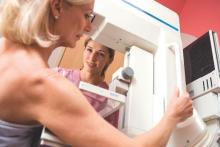Findings that are easily visible on mammograms – but never shared with patients – could be employed as a powerful new tool for cardiovascular risk assessment, a study showed.
In this prospective imaging study, breast arterial calcification in women without heart disease correlated with cardiovascular risk at least as well as the Framingham Risk Score, and a bit better than the 2013 Cholesterol Guidelines Pooled Cohort Equation.
It also increased the accuracy of both of these models for detecting women at high risk for heart disease, Dr. Laurie Margolies said at a press teleconference leading up to the annual meeting of the American College of Cardiology.
If validated in a larger cohort, the findings could well be “practice changing,” said Dr. Margolies, director of breast imaging at Mt. Sinai Hospital, New York.
She compared its potential impact to that of the now-critical breast density measurement for cancer detection. Until 2008, breast density was a visual, yet unreported and unemployed, mammographic finding.
“This is the same type of practice-changing, revolutionary way of reporting risk,” said Dr. Margolies. “We have a practical way of assessing coronary artery disease risk that adds no extra cost, no radiation, and very little time, and is superior to standard ways of [coronary artery disease] risk assessment. And since prevention is key to decreasing cardiovascular mortality, it would be very simple to report this score on all mammographies,” to give both patients and physicians a heads-up that cardiovascular health needs some quick attention.
The study was simultaneously published online (JACC Cardiovasc Imag. 2016 Mar 24. doi: 10.1016/j.jcmg.2015.10.022).
The cohort comprised 292 women who underwent digital screening mammography and a noncontrast chest CT scan during the same year. None had a history of coronary artery disease. Cardiovascular risk was assessed with three tools: the Framingham Risk Score (FRS), the 2013 Cholesterol Guidelines Pooled Cohort Equation (PCE), and the breast arterial calcification (BAC) score. The BAC score encompassed measurements of number of involved vessels, length of involved segments, and calcification density. Scores ranged from 1 to 12 and were classified by increasing severity: 0, 1-3, and 4-12.
Women were a mean of 61 years old; none had a history of coronary artery disease. Hypertension and hyperlipidemia were common (179 and 104 subjects, respectively). Diabetes was present in 79, smoking in 53, and chronic kidney disease in 57.
Any BAC was present in 42.5% of the group. Those with BAC were significantly older and more likely to have hypertension and kidney disease. Coronary artery calcification (CAC) was present in 47.6% of the overall group, but in 70% of those with BAC. These patients were also significantly older than those without CAC. Hypertension, chronic kidney disease, and diabetes were also more common.
The mean BAC score was 2.2. As women aged, the score was more likely to increase. A BAC score greater than 0 was present in 27% of those younger than 60 years, 47% of those aged 60-69 years, and 69% of those aged 70-92 years.
The mean CAC score was 1.6 ,and this also increased with age. The incidence of CAC for the three age groups was 28%, 55%, and 79%, respectively.
In a multivariate model, a severe BAC score of 4-12 conferred a threefold risk for CAC (odds ratio, 3.2), while older age and hypertension conferred a doubling of risk. “This shows us that BAC is a more powerful predictor than these standard risk factors,” Dr. Margolies said.
The mean 10-year Framingham Risk Score was 4.6. Most women in the cohort (85%) were low risk. Of these, 59% had a BAC of 0, and 63% had a CAC of 0. However, there was some disagreement in the models. Among the FRS low-risk group, 15% had an intermediate-risk BAC score of 1-3, and 22% had a high-risk BAC of 4-12. The CAC was intermediate risk in 29% and high risk in 13%.
Among those with an intermediate-risk FRS, the coronary artery calcification and breast arterial calcification scores were also intermediate risk in 45% and 12%, respectively; the CAC and BAC were high risk in 36% and 64%, respectively.
For the entire cohort, the FRS categories agreed with the BAC categories 55% of the time, and with the CAC categories 57% of the time.
The mean Cholesterol Guidelines Pooled Cohort Equation risk score was 11.8. This score tends to overestimate CAC presence, Dr. Margolies noted, an issue supported by the finding that only 42% of the cohort scored as low risk. In this low-risk group, 74% and 76% had CAC and BAC scores of 0, respectively. But in the PCE high-risk group, only 27% had high-risk CAC and 43% had high-risk BAC. In fact, the CAC and BAC scores were actually 0 in 33% and 40%, respectively.



